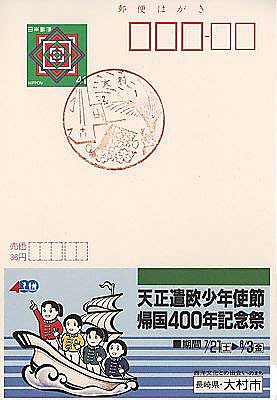

JAPAN, 1982, the 4th centenary of the 1582 Tensho Embassy, Scott 1508
JAPAN, 1990, an echo card marking the 4th centenary of the embassy's return


JAPAN, post marks for Scott 1508 above, 1982 being the 57th year of
the Showa Emperor's era
On February 20, 1582 Alessandro Valignano and other Jesuits set out for Europe with a delegation known as the Tensho Embassy, the Tensho Ken-o Shonen-shisetsu, or the Boys' Delegation to the West during the Tensho Era (1582-1590). The 1982 stamp shows the type of 16th-century ship they sailed on and a map based on the 1570 map by Abraham Ortelius which they brought back with them. The 1990 echo card was issued by the city of Omura to celebrate the 4th centenary of their return. Omura's lord, Omura Sumitada, was one the three Japanese Christian rulers to sponsor the delegation. An echo card is a kind of postal stationery unique to Japan; it bears an advertisement and is sold for less than face value, with the difference being paid by the advertiser.
The mission — to the courts of Philip II of Spain and Pope Gregory XIII — was conceived by Valignano to introduce the Japanese to Europe and to win support for the Jesuit mission in Japan. The four young men who were sent were students in the Jesuit seminary in Arima. They were received as nobles in Europe and sent back with many gifts. The Pope granted the Jesuits the sole right to preach in Japan. But upon their return to Japan, they found that the military leader Toyotomi Hideyoshi had issued an edict of expulsion against the Jesuits in 1587.
The four young men on the card are the two delegates, Mancio Ito and Miguel Chijiwa, and the two assistant delegates, Julian Nakaura and Martin Hara. After their return to Japan, all four on July 25, 1591 joined the Jesuit Order in Amakusa. Chijiwa left the order some two to twelve years later, the other three studied theology in Macao and were ordained to the priesthood in Nagasaki in 1608.
Fr. Mancio Ito, SJ died of disease in Nagasaki in 1612. Fr. Martin Hara, SJ was forced to leave Japan by Tokugawa's expulsion edict of 1614; he joined other Jesuits in Macao and died there in 1639. Blessed Julian Nakaura, SJ, did pastoral work in various parts of Japan, as an underground priest after 1614. He was apprehended in 1632 and after a nine-month imprisonment was put into the torture pit in Nagasaki from October 18 until the 21st when he died. On November 24, 2008 in Nagasaki, Nakaura was beatified in the group known as Blessed Petrus Kibe Kasui, SJ and his 187 Companion Martyrs of Japan.